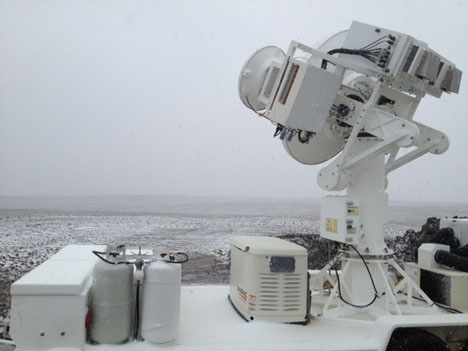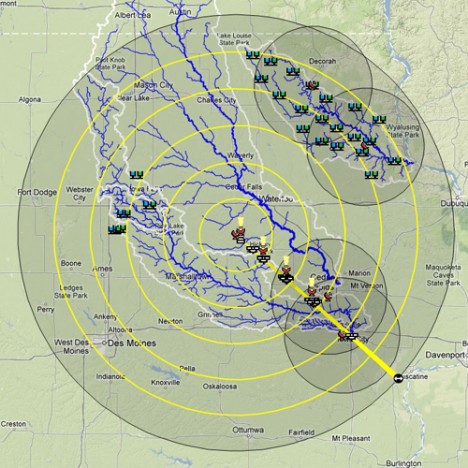Spring Data Collection Features a Winter Mix
May 8th, 2013 by Walt Petersen
The big science highlight so far is that over May 2
through May 4, the GPM Ground Validation team finally collected a
coordinated, co-scanned multi-radar frequency and dual-polarimetric
dataset with the D3R and NPOL radars and we did it in one of the most
complex multi-day precipitation events that we’ll measure in mid and
high latitudes – a mixture of rain, snow and sleet.

In fact, the snowfall portion of the storm turned out to be a record
event for Iowa in May. The fact that D3R and NPOL co-scanned the event
is important because you have a longer wavelength, high power reference
radar (NPOL) with dual-polarization (both vertical and horizontal
scans), and hence enhanced capability to discern specifics on
precipitation shapes, sizes and numbers, scanning coincident with a
radar (D3R) that carries the same higher frequencies that the DPR radar
will carry on the GPM Core Satellite.
The higher frequencies of the D3R are more sensitive, but will often attenuate, or dissipate, faster in the mixture of precipitation we sampled. So, you can test how well you can correct for that attenuation and retrieve the complex precipitation structure from the D3R, which is our proxy for the space-borne radar, against your reference platform, the NPOL. At the same time, we learn a great deal about the precipitation physics when we look at things with 3 different frequencies and in dual-polarization modes.

Moreover, we did this over a “reference” 100 km-long ray of
disdrometers, vertically pointing micro rain radars, and rain gauges –
all in all, what will probably amount to a great deal of information to
interpret.
From May 1 to June 15, NASA and Iowa Flood Center scientists from the University of Iowa will measure rainfall in eastern Iowa with ground instruments and satellites as part of a field campaign called Iowa Flood Studies (IFloodS). They will evaluate the accuracy of flood forecasting models and precipitation measurements from space with data they collect. Walt Petersen, a scientist based at NASA’s Wallops Flight Facility, is the Ground Validation Scientist for the Global Precipitation Measurement (GPM) mission.

May
3, 2013. The D3R radar, which measures precipitation at similar
frequencies as the radar on the GPM Core satellite, measured rain, snow,
and sleet at the Traer site in Iowa. Credit: Walt Petersen / NASA
The higher frequencies of the D3R are more sensitive, but will often attenuate, or dissipate, faster in the mixture of precipitation we sampled. So, you can test how well you can correct for that attenuation and retrieve the complex precipitation structure from the D3R, which is our proxy for the space-borne radar, against your reference platform, the NPOL. At the same time, we learn a great deal about the precipitation physics when we look at things with 3 different frequencies and in dual-polarization modes.

Map
of field locations of IFloodS instruments. The NPOL and D3R radars are
located dead center and a ray of disdrometers and rain gauges stretches
southeast toward Iowa City in the bottom right. Other rain sensors are
distributed throughout the Turkey River basin in the north east and the
south fork of the Iowa river west of Traer. Credit: Iowa Flood Center
From May 1 to June 15, NASA and Iowa Flood Center scientists from the University of Iowa will measure rainfall in eastern Iowa with ground instruments and satellites as part of a field campaign called Iowa Flood Studies (IFloodS). They will evaluate the accuracy of flood forecasting models and precipitation measurements from space with data they collect. Walt Petersen, a scientist based at NASA’s Wallops Flight Facility, is the Ground Validation Scientist for the Global Precipitation Measurement (GPM) mission.
NASA: Blogs - Spring Data Collection Features a Winter Mix - 09.05.13
Ricardo Marcenaro
Sculptures – Esculturas
http://ricardomarcenaro.ning.com/
Ricardo M Marcenaro - Facebook
Blogs in operation of The Solitary Dog:
Solitary Dog Sculptor:
http://byricardomarcenaro.blogspot.com
Solitary Dog Sculptor I:
http://byricardomarcenaroi.blogspot.com
Para:
comunicarse conmigo,
enviar materiales para publicar,
propuestas comerciales:
marcenaroescultor@gmail.com
For:
contact me,
submit materials for publication,
commercial proposals:
marcenaroescultor@gmail.com
Diario La Nación
Argentina
Cuenta Comentarista en el Foro:
Capiscum
My blogs are an open house to all cultures, religions and countries. Be a follower if you like it, with this action you are building a new culture of tolerance, open mind and heart for peace, love and human respect.
Thanks :)
Mis blogs son una casa abierta a todas las culturas, religiones y países. Se un seguidor si quieres, con esta acción usted está construyendo una nueva cultura de la tolerancia, la mente y el corazón abiertos para la paz, el amor y el respeto humano.
Gracias :)

No hay comentarios:
Publicar un comentario